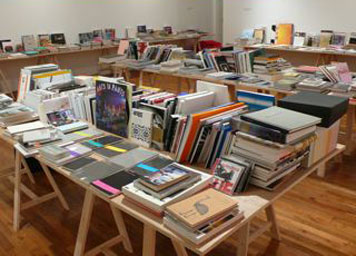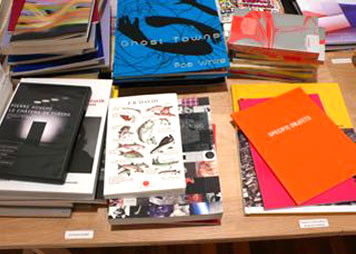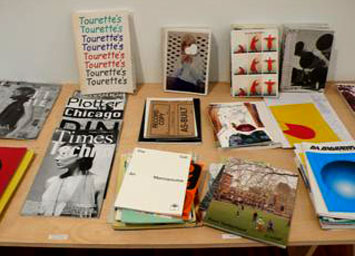
Kiosk: Modes of Multiplication exhibition. Photograph by Alice Twemlow.
According to the Mexican critic Gabriel Zaid, writing in So Many Books: Reading and Publishing in an Age of Abundance, the human race publishes a book every 30 seconds. If current trends continue, by 2052 the number of people writing and publishing a book in a given year will exceed the number of people who will read one. Zaid sympathizes with the overwhelmed reader and points the finger at the inconsiderate author for whom, in extreme cases of verbosity, he recommends a "chastity glove."
Publishers like Nieves in Zurich, J&L Books in New York, Roma Publications in Amsterdam, or Gas in Tokyo, are publishing artists' work and the research and ideas generated from thinking about art. They are passionate about their missions, mostly locally focused and non-commercial in attitude. The quality of their work is often very high; their books well-conceived and produced, and innovatively designed.
But the question is, who is reading them?
The fecundity of contemporary publishing was brought home to me recently when I visited Kiosk: Modes of Multiplication, a traveling exhibition of independent publications on contemporary art. Christoph Keller, founder of the Frankfurt publishing house Revolver, launched the project in 2001 with a handful of books and it has been on the road ever since accumulating titles along the way. In its current configuration, in the Artists Space gallery in New York, 5,300 books and magazines are on display, the output of 360 independent publishing houses from all over the world. On the one hand, it's exciting to see that independent publishing on the visual arts is in such good health. On the other, it's hard to know what to make of such unmediated abundance.

Kiosk: Modes of Multiplication exhibition. Photograph by Alice Twemlow.
"Books are published at such a rapid rate that they make us exponentially more ignorant," writes Zaid. "If a person read a book a day, he would be neglecting to read 4,000 others... and his ignorance would grow 4,000 times faster than his knowledge." The idea that any individual would consider herself responsible for digesting this vast body of information is, of course, absurd. No one reads all of the publications even on a fairly limited subject such as contemporary art. In the 18th century a publisher could be sure of their readership for a particular book, since it was the subscriptions of prospective readers that funded its printing. Today, however, as any independent publisher will tell you, readers are tough to come by. "Sometimes it's hard to find 20 of them," says Keller of his own attempts to locate an audience.
Why keep on with the work of traditional publishing when the Internet would seem to provide a much more efficient means for reaching people? What is it about the book, pamphlet and magazine formats that continue to lure publishers onto the rocks of insolvency?
Perhaps it's the level of control that books afford. They are created from the top down: completed and finessed before their release, they provide few entry points for unpredictable reader contributions. Books are statements, serene and imperturbable.
In the age of "new media," it's the history of publishing that appears to provide much of the inspiration and content for today's visual arts publishers. Now that the larger projects of news and reference dissemination can be taken care of online, printed publications become available for the exploration of increasingly idiosyncratic obsessions — the more quirky, obscure and esoteric, the better. These publications have a very particular voice and visual appearance both of which derive from the dustier corners of book publishing's history: the heavily footnoted meanderings of science textbooks, earnest political treatises and tracts, hobby manuals and the like. For many, the ultimate goal is to channel the essence of an out-of-print illustrated pamphlet on the preferred techniques for the propagation of indoor ivy plants. The best-known touchstones of this meticulously arcane tone can be found in the satirical output of the McSweeney's empire and the Society for the Diffusion of Useful Information Press, for example.

Kiosk: Modes of Multiplication exhibition. Photograph by Alice Twemlow.
The publications at Artists Space, organized by publisher, rather than by author or artist, are heaped in piles on trestle tables. Those that work their way to the surface during my visit seem typical of this self-reflexive fascination with publishing: One is a book by Martin Beck, part of Florian Pumhösl's Montage series, titled half modern half something else (Charles Jencks, the Language of Post-Modern Architecture, first, second, third, fourth, fifth, sixth and seventh editions.) By reproducing the covers, and providing a comparative review of each edition of Jencks' book published between 1977 and 2002, Beck highlights the role of design and publishing in shaping the genealogy of architectural theory during this period. On the table of books made by designers turned publishers is Tourette's, a magazine that reproduces texts about art, located and collated by designers Will Holder and Stuart Bailey. Another project that reprints existing texts about art, and which uses the format of a paperback book with 19th century field guide style illustrations of fish on the cover, is FR David, a quarterly journal published by the de Appel Arts Center. Other books plumb the web for their content. Susanne Burner's lo-fi, one-color pamphlet titled Vanishing Point: How to Disappear in America without Leaving a Trace, for example, presents, with deadpan reverence, an edited version of an anonymous text she found on skeptic-tank.org.
The creators of such publications do not expect large readerships — nor do they depend upon sales. Instead their enterprises are funded by subsidies in Europe and in the U.S. many have opted for non-profit status. As Keller has pointed out, "All these art books would cost a fortune if they were rooted in a capitalistic market system... Of the 500 books I have published with Revolver, more than half the copies have been given away or swapped for other books." Such books function primarily as a currency within the network of other artists, other publishers, and other designers who share their particular sensibility. Yet even though their influence may at first seem limited to the initiated, over time it grows, helped by such project's as Keller's Kiosk which, after being shown at 20 venues, will be made available as an online research tool by the Berlin State Library. In Zaid's words, "to establish a publishing house... is to start a conversation — a conversation that springs, as it should, from local debate, but that opens up, as it should, to all places and times."
Alice Twemlow is a design writer and the chair of a new MFA program in Design Criticism at the School of Visual Arts in New York.
